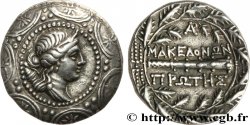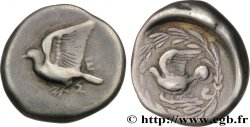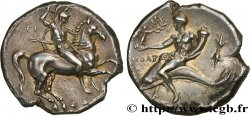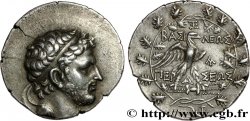v51_0149 - CYCLADES - NAXOS ISLAND - NAXOS Didrachme
MONNAIES 51 (2011)
Starting price : 4 500.00 €
Estimate : 7 500.00 €
Realised price : 4 500.00 €
Number of bids : 1
Maximum bid : 5 218.00 €
Starting price : 4 500.00 €
Estimate : 7 500.00 €
Realised price : 4 500.00 €
Number of bids : 1
Maximum bid : 5 218.00 €
Type : Didrachme
Date: c. 200-180 AC.
Mint name / Town : Cyclades, Naxos
Metal : silver
Diameter : 23 mm
Orientation dies : 12 h.
Weight : 7,86 g.
Rarity : UNIQUE
Coments on the condition:
Exemplaire de qualité exceptionnelle pour ce type de monnayage sur un flan ovale, bien centré des deux côtés. Très beau portrait de Dionysos. Très joli revers de style fin, de haut relief, bien venu à la frappe. Très jolie patine de collection ancienne avec des reflets dorés. Conserve une partie de son brillant de frappe et de son coupant d’origine
Catalogue references :
Predigree :
Cet exemplaire provient de la collection de Serge Boutin, de la vente Sternberg XIX, 18-19 novembre 1987, n° 173 et de la vente Weil des 15 et 16 novembre 1994, n° 23
Obverse
Obverse legend : ANÉPIGRAPHE.
Obverse description : Tête barbue de Dionysos à droite, couronné de vigne, les cheveux longs tombant sur la nuque.
Reverse
Reverse description : Cratère décoré ; thyrse dans le champ à droite.
Reverse legend : NAXI/ EPIF[A]
Reverse translation : (des Naxiens/ Epipha...).
Commentary
Cet exemplaire est illustré dans l’article de référence d’Hélène Nicolet-Pierre, Les cratérophores de Naxos (Cyclades) : émissions monétaires d’argent à l’époque hellénistique, RN. 154, 1999, p. 99, n° 12, pl. XIV (monétaire 6) (A/ 4 - R/ 7). Type et exemplaire de la plus insigne rareté. Actuellement unique et seulement deux exemplaires recensés pour le magistrat. C’est la première fois que nous proposons ce type à la vente.
This example is illustrated in the reference article by Hélène Nicolet-Pierre, Les craterophores de Naxos (Cyclades):émissions monétaires d'argent à l'époque hellénistique, RN. 154, 1999, p. 99, n° 12, pl. XIV (monetary 6) (A/ 4 - R/ 7). Type and example of the most remarkable rarity. Currently unique and only two examples recorded for the magistrate. This is the first time that we offer this type for sale
This example is illustrated in the reference article by Hélène Nicolet-Pierre, Les craterophores de Naxos (Cyclades):émissions monétaires d'argent à l'époque hellénistique, RN. 154, 1999, p. 99, n° 12, pl. XIV (monetary 6) (A/ 4 - R/ 7). Type and example of the most remarkable rarity. Currently unique and only two examples recorded for the magistrate. This is the first time that we offer this type for sale








 Report a mistake
Report a mistake Print the page
Print the page Share my selection
Share my selection Ask a question
Ask a question Consign / sell
Consign / sell










